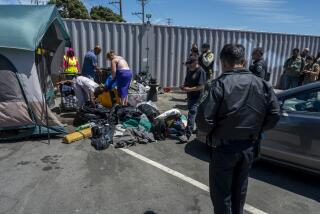Galanter to Open Center for Homeless
- Share via
Homeless people in Venice called for more services, but residents called for fewer homeless at a raucous and often unruly public hearing in Venice High School last week.
More than 1,000 people, from the bedraggled to the bejeweled, crammed into the crowded meeting Thursday night called by Los Angeles Councilwoman Ruth Galanter.
Galanter told the crowd that she was determined to find a solution to the problem that has plagued the community.
Challenge to City
“It is a challenge that . . . the whole city must look squarely in the eye until we find both the ways and the means to deal with it,” Galanter said.
Before the meeting, Galanter’s staff disclosed her tentative plans to open a homeless processing office at the Venice Pavilion this week. Vagrants living on the beach will be given two weeks to apply for social service programs, including options for housing, according to Galanter spokesman Rick Ruiz. Afterward, police will order any remaining homeless people off the beach. Galanter did not announce her plans at the meeting which ran nearly three hours.
At that session, Susan Chevalier, a 15-year Venice resident, told Galanter that officials must recognize the rights of private citizens. Chevalier said that vagrants are destroying the quality of life in Venice.
“How many intoxicated bodies do we have to step over to get to the beach?” she asked. “How much should any community endure before something is done?”
Reclaim the Beach
Jo Giese, another resident, drew thunderous applause when she said that residents must reclaim the beach. “We are interested in helping the truly needy homeless,” she said, “but not at the expense of the community.”
Several self-described homeless people also spoke at the hearing. Bo Taylor, a leader of Venice’s homeless, said that a vast array of social service programs are needed.
Jon Hilldale, another homeless person, said the problem is political. There would be no vagrants, he said, if the government provided proper services.
“The homelessness problem is a pimple on the body politic of America,” he said.
Social service experts generally supported the homeless, saying that the city and the county should be doing much more.
“There is a real and urgent need in the community,” said Betty Macias of the Ocean Park Community Center. “How do we expect people to leave the parks and leave the beaches when we don’t provide viable alternatives?”
Need for Shelters
Rhonda Meister of the St. Joseph Center said the greatest need is for additional shelters. She said officials also should work to preserve existing affordable housing and create new jobs.
Ron Frankel, deputy chief of the Los Angeles Police Department, said law enforcement officials are doing everything they can to control troublesome vagrants. He said their job would be easier if the city received more cooperation from the county, and he asked why county Supervisor Deane Dana, whose district includes Venice, was not at the hearing.
However, Frankel said residents had no cause for alarm.
“Are we going to have a wave of lawlessness on the beach?” he asked. “The answer is, absolutely not.”
The Galanter hearing was spurred by community complaints last month that Venice was being overrun by homeless people. The councilwoman, who was elected in June, has said that the vagrant issue is one her most pressing problems.
2,500 Homeless People
Recent studies have shown that the Bohemian beach community is home to up to 2,500 transients. Officials say that a large percentage of vagrants have migrated to Venice from Skid Row in Los Angeles.
In a recent study by a group called the Venice Task Force on the Homeless, vagrants blamed economic pressures, stress, family problems, mental breakdowns and joblessness for their lot in life. More than a third had been homeless for a year or longer and more than half said that they were seeking employment.
Social workers say that services for the homeless are grossly inadequate. The Venice Task Force on the Homeless, in a report issued last month, estimated that the Venice-Santa Monica area has 14% of the county’s vagrant population but receives only 2% of county funding for the homeless.
Some vagrants have pitched makeshift tents on the beach which they jokingly refer to as “sand-ominiums.” Others live in cars or sleep in alleys or on sidewalks.
Venice’s homeless population has been accused by some residents of being responsible for crimes such as panhandling, stealing and drug dealing.
More to Read
Sign up for Essential California
The most important California stories and recommendations in your inbox every morning.
You may occasionally receive promotional content from the Los Angeles Times.






